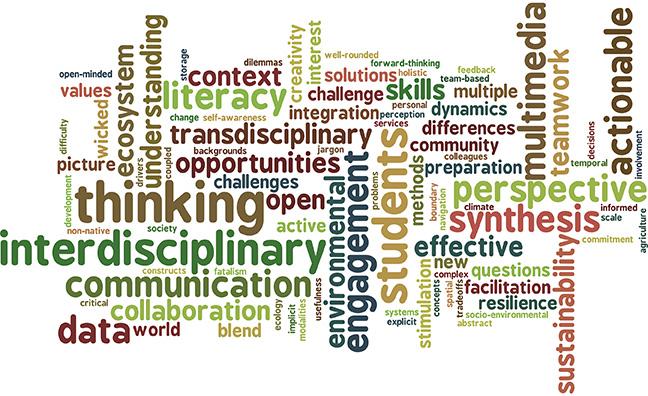Question: What are the topics, concepts, and competencies associated with teaching socio-environmental synthesis (SES)?
Answer:

By glancing at this word cloud generated by participants of Teaching Socio-Environmental Synthesis with Case Studies, the short course recently hosted at the National Socio-Environmental Synthesis Center (SESYNC), it is clear that SES involves a broad suite of topics, concepts, and competencies. However, the words above—though they hint at the complexity of SES—still do not capture the essence of what it means to teach SES, as it is more than just a collection of topics, concepts, and competencies. Rather, it is a problem-solving approach, and the key to learning about SES lies in the examples—in the details of the profound socio-environmental problems that SES addresses.
Stories are keys to student learning. Teaching is most effective when students are engaged, and a compelling way to draw students in is to relate the lesson to something students care about and are interested in. This is the basis of the case study method of teaching, a high-impact, active-learning pedagogy. Given the problem-based focus of SES, this approach is a good fit for teaching SES. Thus, a course that introduces participants to this teaching approach and helps them build SES-focused case study activities of their own serves as a good place to start our short course offerings.
The short course, held at SESYNC on July 23–26, 2013, drew 41 participants from across the country, and one participant from across the Atlantic. Participants included professors, graduate students, and postdocs from a variety of disciplines in the natural and social sciences, all with varying degrees of familiarity with SES. Each participant, whether as part of a team or as an individual, came to the course prepared to write their own SES case study. Following an introductory day focused on addressing the question of “what does it mean to teach socio-environmental synthesis,” participants then focused on the question of how to teach SES and were introduced to case study teaching by Dr. Clyde Herreid, Director of the National Center for Case Study Teaching in Science, who expertly guided them through a series of exercises designed to help them develop their own cases.
Participants quickly discovered—as SESYNC postdocs Dr. Judy Che-Castaldo and Dr. William Burnside and I discovered earlier when writing two SES cases of our own for this course—that writing a SES case study for use in a classroom can be very challenging given the complexity of socio-environmental problems. However, participants also discovered the appeal of teaching SES with the case study method. Not only is it an active and engaging way to teach, but it is also a flexible approach that lends itself well to modification for different courses. Of the many types of case study activities, several are particularly appropriate for teaching the collaborative and interdisciplinary competencies critical for SES. For example, for a case that Dr. Che-Castaldo, Dr. Burnside, and I wrote on endangered species recovery, students work collaboratively in small groups to prioritize conservation efforts for a small number of endangered species based on several data sets. When this exercise is used with students from different majors, it also becomes an exercise in interdisciplinary collaboration.
Over the three-and-a half-day course, a steady buzz of conversation filled the common area of SESYNC as participants dove into writing their cases. Once completed, this collection of SES-related case studies teaching activities will be made available online for others to use either in their own classrooms or as templates for developing their own activities.
The course ended as it began—with words from the participants. This time, a response to how they were feeling at the end of the course: “motivated,” “inspired,” “overwhelmed,” “informed,” “encouraged,” and “pumped!” If I were to add a word, it would be “grateful”—for the opportunity to meet this insightful and dedicated group of scientists and educators.